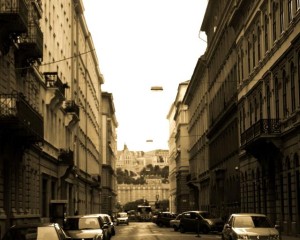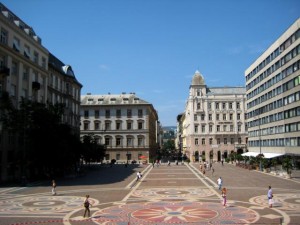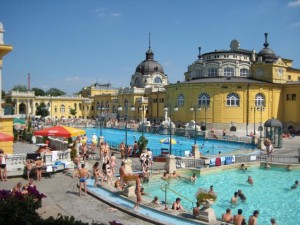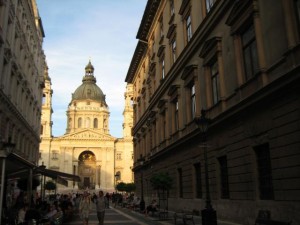Wed 20 Aug 2008
Getting Hungary
Posted by Shanna under Hungary
[2] Comments

The twentieth century was a tough one for Hungary. Until then, the nation had been one half of Austria-Hungary, one of the most powerful empires on earth. World War I brought widespread destruction to the land, both during and after the actual conflict. Hundreds of thousands of Hungarians were killed in battle, and under a post-war settlement known as the Treaty of Trianon, Hungary’s territory was reduced to 40% of its historical size. It’s said that, even today, “Trianon” remains a dirty word within Hungarian borders.

During the years between the world wars, Hungary trained its focus on reclaiming its lost land. It couldn’t turn to the U.S., Britain or France for help in this matter (as the WWI victors, they were the ones who’d taken it away in the first place), so it looked instead to the fascist governments of Italy and Germany, joining them in their fight for territorial domination. Bad idea. World War II decimated Hungary even further, opening the door to 40 years of harsh communist rule.

All of this strife seems to have left Hungarians in a bad mood. Their national anthem speaks of them as “a people torn by fate,” and their prevailing sentiment is said to be one of “patriotic sorrow.” Unfortunately, they take their sorrow quite seriously: their suicide rate is one of the highest in the world. But perhaps things are turning around for this nation of goulash and paprika. Democracy arrived in 1991, and Hungary was admitted to the EU in 2004. Those are always good signs, right? We spent about a week there, and it seems to us that Hungarians have quite a lot to be happy about. (Of course it does. As we’ve learned on this trip, Americans are known throughout the world as being impossibly optimistic.)

Budapest alone should be enough to change someone’s outlook on life. Divided in half by the Danube, ((Did you know that Budapest is actually made up of two parts? Buda lies on one side of the river, Pest on the other.)) both sides of the city are beautiful. Spectacular architecture and fine arts abound, as do world-class museums and delectable restaurants, many of which don’t seem to be entirely on the tourist map yet. That, of course, makes them even better.

As it turns out, though, one of our favorite parts of the city was one of its most well known. Budapest lies on a geographical fault line, from which 30 million liters of hot mineral water gush every day. These waters are funneled into the many thermal bath houses that dot the city. “Taking the waters” at one of these baths is said to be one of the ultimate Budapest experiences. And it was. One afternoon, we joined throngs of locals and tourists at the bright yellow Szechenyi baths. We immersed ourselves in pools of all shapes, sizes and temperatures. Some were tiny and scalding; others were clouded with minerals; still others were chlorinated and felt kind of like the wave pools I used to love as a kid. We left feeling refreshed and–I’m not kidding–just a little bit healthier.

If the baths aren’t enough of an escape from the hustle and bustle of big-city Budapest, Hungarians can always head a couple hours outside of town to Villany, a village of vineyards that feels like Napa Valley probably did about 100 years ago. The bulk of the small hamlet is situated around a single road, which is referred to by everyone in town as, simply, “the cellar street.” And for good reason. Every second building or so is a little, family-run wine cellar, complete with a tasting room and, perhaps, a small restaurant. As we sampled the local wares, we watched locals stop by with big, plastic jugs, loading up on a week’s supply of the celebrated reds that have made their hometown famous. Good vino… That ought to improve their mood.
[embedplusvideo height=”350″ width=”450″ editlink=”http://bit.ly/1r6enD8″ standard=”http://www.youtube.com/v/xrioo58WPhg?fs=1″ vars=”ytid=xrioo58WPhg&width=450&height=350&start=&stop=&rs=w&hd=0&autoplay=0&react=1&chapters=¬es=” id=”ep1148″ /]
Google Video
Hey you guys – we were in Paris and Vienna earlier in the month and also went to
Budapest by train for one day from Vienna – we went to the same baths and really enjoyed all of Budapest! How fun to see the photos of the baths that we were at a couple weeks earlier! I have loved reading your blog – and traveling vicariously thru you! Can’t believe it’s almost over – and then your Real Life begins! Love Jody
thanks for the history.